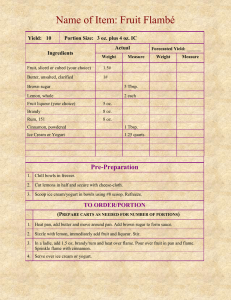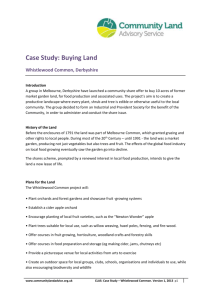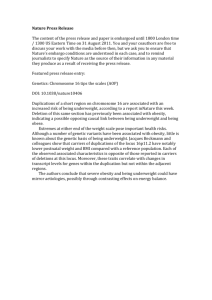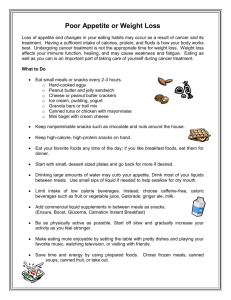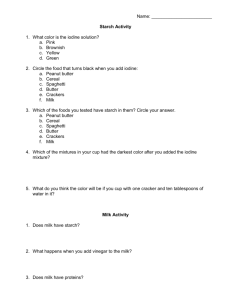a guide for older people who are underweight
advertisement
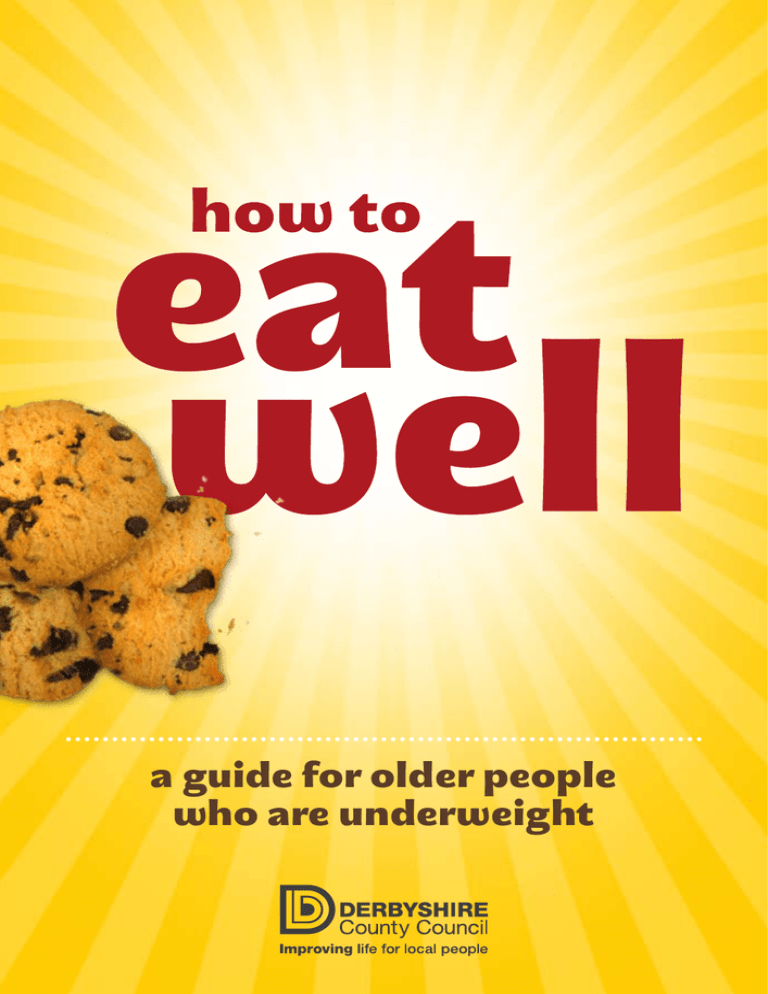
a guide for older people who are underweight 2 Foreword A message from Carol Hart, Derbyshire County Council’s cabinet member for public health. This booklet contains healthy eating guidelines specifically for older people who are unintentionally losing weight and need to put weight back on. This particular group of people needs to put on weight in order to maintain health and boost their ability to fight infections. This means that if you are older and losing weight, most healthy eating guidelines we hear or see in the media don’t apply to you. We are often bombarded with health messages these days. We can scarcely turn on the television or open a newspaper without being urged to eat five fruit and vegetables a day or to lower our cholesterol, for example. But what might be sensible healthy eating guidelines for some, will not do for all. If you, or someone you know, is older and losing weight, then an enriched diet is what is called for. More calories must be consumed to put weight back on. This booklet contains many helpful suggestions on how to do this – such as not skimping on puddings and snacks, choosing full fat dairy products and eating smaller meals with snacks in between if a big meal seems too daunting. Being underweight makes people more susceptible to health problems and leads to avoidable hospital admissions. No one likes going into hospital and, of course, it has cost implications for the NHS. Despite the fact that we are living longer and generally healthier lives than our ancestors did, we cannot afford to neglect our health as we grow older. We want everyone in Derbyshire to lead healthy and happy lives. We hope this booklet helps. Councillor Carol Hart How to eat well: a guide for people who are underweight. 3 There are many reasons why you might not feel like eating as much as you used to Sometimes you just don’t feel like eating a big meal. Maybe you’ve been under the weather and you’ve lost your appetite. You could be trying to save money on fuel. Or if you live alone it can feel like a lot of bother cooking for one. But if you’re not getting enough to eat every day the result can be weight loss and malnutrition – which will harm your health. Pay less attention to the healthy eating messages – things like five-a-day and low fat. If you’re older and losing weight those messages aren’t right for you as you need to build yourself up. We’re not saying don’t eat fruit. We are saying fill up on high-calorie snacks before you fill up on fruit. Our guide contains practical advice on how to eat well as an older person who is losing weight. It will also be useful if you are caring for someone who you have noticed is losing weight. If you have specific dietary concerns regarding diabetes, coeliac disease or renal disease ask for further guidance from your GP or dietitian. And don’t forget, always get advice from your doctor to rule out any underlying medical reason for weight loss. How to eat well: a guide for people who are underweight. 4 Eating well with a small appetite Weight loss or a low appetite can lead to tiredness, depression and a lack of energy which may make you more likely to suffer from infections such as colds, flu etc. In order to feel healthy it is important that your diet contains enough energy (calories), protein and other nutrients. Eating well will help to keep your bones and muscles strong and your bowels regular, while helping you to think clearly. How to eat well: a guide for people who are underweight. 5 Here are some helpful hints Always talk to your doctor if worried about your weight and eating. You could take this booklet with you. Don’t try to eat too much in one go. Aim to have at least three small meals each day with two or three snacks or milky drinks in between. Most supermarkets offer a delivery service. Small portions are often more appealing and can be followed by a second helping. Derbyshire Gold Card holders can get discounts at lots of cafes, pubs and restaurants so eating out doesn’t have to break the bank Try not to have a drink just before a meal as this may fill you up. Fresh air and exercise can help to stimulate your appetite. Try to include a pudding once or twice a day. Milk pudding, trifle, custard, cake and full fat yogurt are nourishing choices. Allow family and friends to help you with shopping and mealtimes. A light meal can be as good as a cooked meal. Try scrambled eggs, beans on buttered toast or fortified soup and a sandwich. Add variety to your diet and try to include your favourite foods. Consider using ready prepared meals and convenience foods if you find meal preparation difficult. Individually portioned or wrapped items such as mini-cakes or desserts will minimise food wastage. Companies such as Wiltshire Farm Foods and Oakhouse Foods can provide frozen meals direct to your door. How to eat well: a guide for people who are underweight. Add double cream to soups, sauces, cereals, puddings and mashed potatoes. Fats and sugars are a good source of energy, so use them generously to increase the amount of calories you eat. Diabetics should not add extra sugar or honey to their diet. 6 Small snacks and milky drinks to have between each meal and at supper A savoury snack – cheese and crackers, bhaji, scotch egg, mini sausage roll, small sandwich, crisps, Bombay mix, cheese biscuit. Luxury biscuit – shortbread, chocolate coated. Breadsticks and a dip such as cream cheese, hummus or guacamole. Hot chocolate, malted drink, cup-a-soup or milkshake made with fortified milk (see p12). Small cake – chocolate roll, fondant fancy, egg custard, fruit pie. Scone, teacake, roti, crumpet, scotch pancake with margarine or butter. Mini chocolate bar, a choc-ice or a few sweets. Individual dessert – full-fat yogurt, trifle, crème caramel, cheesecake, rice pudding. How to eat well: a guide for people who are underweight. 7 Make every mouthful count by adding extra nourishment to your food and drink Always use full fat milk instead of water in drinks such as coffee, hot chocolate, malted drinks and cup-a-soups. Try a cold glass of milk with milkshake flavouring and aim to have at least one pint of milk each day. Make fortified milk by adding two tablespoons of skimmed milk powder (Marvel or supermarket’s own) to one pint of milk. Use this in drinks and cooking as you would ordinary milk to increase the calorie and protein content. Add sugar or honey to drinks, breakfast cereals and fruit (not for diabetics). Add margarine or butter (not low-fat spread) generously to potatoes and vegetables. Add full fat plain yogurt to casseroles, soup, mashed potato etc. Add fruit yogurt to puddings, milkshakes, breakfast cereals etc. Add syrup, jam, chocolate sauce, double cream, evaporated milk or ice cream to puddings and desserts. Add cream, grated cheese or cream cheese to potatoes, soups, sauces and casseroles. Avoid foods labelled low-fat, diet, sugar-free or healthy choice. Grated cheese, butter, margarine, cream, evaporated milk, milk powder Can be added to soup, curry, potatoes, vegetables and sauces Sugar, honey, jam, syrup, cream, evaporated milk, yogurt, nuts, dried or fresh fruit Can be added to breakfast cereals and puddings Fresh or tinned fruit, yogurt, evaporated milk, ice cream, cream, milkshake powder, cocoa, drinking chocolate, Horlicks, Ovaltine, Bournvita, sugar, honey, syrup Can be added to full cream milk How to eat well: a guide for people who are underweight. 8 Getting the balance right so that your body gets a variety of nutrients Drink at least 8-10 glasses of fluid each day – this includes fruit juice, milky drinks, tea, coffee and water. Try to have at least one portion of fruit each day and/or a glass of fresh fruit juice or fruit cordial rich in vitamin C. Try to include protein foods in at least two meals each day such as meat, poultry, fish, beans, pulses, dahl, dairy foods, and eggs. Try to include an energy food at each meal, such as bread, potato, rice, pasta or cereals. Have some foods rich in calcium and Vitamin D for healthy bones. Calcium is found in milk, eggs and yogurt. We get Vitamin D from the effect of sunlight on our skin as well as from sardines, margarine and fortified breakfast cereals. Take a routine daily multivitamin. How to eat well: a guide for people who are underweight. 9 Be observant How can I tell if I, or someone I know, is losing weight? When it’s you, or someone you see every day, you may not always notice change over time. But keep these signs in mind: Other signs to look out for: Are rings looser on fingers? Having dizzy spells. Are shirt collars looser? Suffering from dry skin or pressure sores. Do slippers that once fit seem too big now? Eating and drinking less than usual. Are skirts and trousers loose around the waist? Do dentures fit less well? (gums receding) Are limbs thinner than before? Do belts need to go on a tighter notch? Finding it hard to keep warm. Suffering from diarrhoea or constipation. Having mouth problems – swallowing and chewing, sore mouth or tongue, bleeding or swollen gums, teeth problems, choking problems. Getting frequent infections. Finding it hard to shake off colds and infections. How to eat well: a guide for people who are underweight. 10 Do you know what is a healthy weight? BMI (body mass index) is a measure of your weight in proportion to your height. Height (feet and inches) 67 65 63 61 59 Weight (kg) 57 55 53 51 49 47 45 43 41 39 68 66 64 62 60 58 56 54 52 50 48 46 44 42 40 38 31 31 30 30 29 29 28 28 27 27 26 26 26 25 25 24 24 23 23 22 22 21 21 21 20 20 19 19 18 18 17 5'0 30 30 29 29 28 28 28 27 27 26 26 25 25 24 24 24 23 23 22 22 21 21 20 20 20 19 19 18 18 17 17 1.48 29 29 29 28 28 27 27 26 26 26 25 25 24 24 23 23 23 22 22 21 21 20 20 19 19 19 18 18 17 17 16 5'11 ½ 5'0 ½ 5'2 5'4 5'5 ½ 5'7 5'8 ½ 5'10 6'1 6'3 5'1 ½ 5'3 5'4 ½ 5'6 5'7 ½ 5'9 ½ 5'11 6'0 ½ 6'2 29 28 28 27 27 27 26 26 25 25 24 24 24 23 23 22 22 22 21 21 20 20 19 19 19 18 18 17 17 16 16 1.52 1.50 28 28 27 27 26 26 25 25 25 24 24 23 23 23 22 22 21 21 21 20 20 19 19 18 18 18 17 17 16 16 16 27 27 26 26 26 25 25 24 24 24 23 23 22 22 22 21 21 20 20 20 19 19 18 18 18 17 17 16 16 16 15 1.56 1.54 27 26 26 25 25 25 24 24 23 23 23 22 22 21 21 21 20 20 20 19 19 18 18 18 17 17 16 16 16 15 15 26 26 25 25 24 24 24 23 23 22 22 22 21 21 21 20 20 19 19 19 18 18 18 17 17 16 16 16 15 15 14 1.60 1.58 25 25 25 24 24 23 23 23 22 22 22 21 21 20 20 20 19 19 19 18 18 17 17 17 16 16 16 15 15 15 14 25 24 24 24 23 23 22 22 22 21 21 21 20 20 20 19 19 19 18 18 17 17 17 16 16 16 15 15 15 14 14 1.64 1.62 24 24 23 23 23 22 22 22 21 21 21 20 20 19 19 19 18 18 18 17 17 17 16 16 16 15 15 15 14 14 13 24 23 23 22 22 22 21 21 21 20 20 20 19 19 19 18 18 18 17 17 17 16 16 16 15 15 15 14 14 13 13 1.68 1.66 23 23 22 22 22 21 21 21 20 20 20 19 19 19 18 18 18 17 17 17 16 16 16 15 15 15 14 14 14 13 13 22 22 22 21 21 21 20 20 20 19 19 19 18 18 18 18 17 17 17 16 16 16 15 15 15 14 14 14 13 13 13 1.72 1.70 22 22 21 21 21 20 20 20 19 19 19 18 18 18 17 17 17 16 16 16 15 15 15 15 14 14 14 13 13 13 12 21 21 21 21 20 20 20 19 19 19 18 18 18 17 17 17 16 16 16 15 15 15 15 14 14 14 13 13 13 12 12 1.76 1.74 21 21 20 20 20 19 19 19 19 18 18 18 17 17 17 16 16 16 15 15 15 15 14 14 14 13 13 13 12 12 12 21 20 20 20 19 19 19 18 18 18 18 17 17 17 16 16 16 15 15 15 14 14 14 14 13 13 13 12 12 12 11 1.80 1.78 20 20 19 19 19 19 18 18 18 17 17 17 17 16 16 16 15 15 15 14 14 14 14 13 13 13 12 12 12 12 11 20 19 19 19 18 18 18 18 17 17 17 16 16 16 16 15 15 15 14 14 14 14 13 13 13 12 12 12 12 11 11 1.84 1.82 19 19 19 18 18 18 18 17 17 17 16 16 16 16 15 15 15 14 14 14 14 13 13 13 12 12 12 12 11 11 11 19 19 18 18 18 17 17 17 17 16 16 16 16 15 15 15 14 14 14 14 13 13 13 12 12 12 12 11 11 11 11 10 10 10 8 10 6 10 3 10 1 9 13 9 11 98 96 94 92 90 8 11 89 87 85 83 80 7 12 1 10 78 76 73 71 6 13 6 11 69 66 64 62 60 1.88 1.86 1.90 Height (m) Note: The green area indicates a healthy weight range. If your weight is outside this range talk to your doctor. The figures have been rounded to the nearest whole number. If you know your weight you can consult the chart above. A BMI of less than 20 indicates underweight. Get in touch with the doctor. For example, if someone is 5'2" and weighs 7st 3lb or less their BMI is 18 and they are underweight. Or if they are 5'10" and 9st 2lb their BMI is also 18 and they are underweight. How to eat well: a guide for people who are underweight. Weight (stones and pounds) 4'11 4'10 ½ 11 If you are a carer Carers can include husbands, wives, partners, children or any relative looking after or visiting an older person – not just a professional carer. If you are a carer you can help by: Visiting at meal times so you can eat together and see if they’re eating well. Encouraging them to eat socially with friends and family. Remind them that Gold Card holders can get discounts at lots of cafes, pubs and restaurants so eating out doesn’t have to be expensive. Offer to help with shopping and writing a shopping list so you can both make sure there’s nourishing food within date to choose from. Encourage extra high-calorie drinks and snacks. Look into lunch clubs, meal delivery services or supermarket delivery. Contact social and health services for further advice, but ask the older person first. Ask the person to weigh themselves, so you can both keep track of weight lost and gained. Reassure them that three square meals a day doesn’t have to be the rule. It’s fine to eat little and often and to snack between meals. If you’re a carer, you can contact someone’s GP if you think it necessary – they won’t breach confidentiality but they can take note of your concerns. How to eat well: a guide for people who are underweight. 12 Here’s a few simple recipes to help you add calories to your diet ge Creamy porrid Serves one Ingredients ge oats • Half a cup porrid ilk or • 1 cup full cream m ee below) (s high-calorie milk • Small pinch salt. sp) • 1 dessert spoon (d double cream lden syrup • 1 dsp honey or go e.g apricots • 1 dsp dried fruits d milk in a Mix porridge, salt an wl. microwave-safe bo for two minutes, Microwave on high h. Leave to stand stir half way throug for one minute. zle over Stir in cream, swiz High-ca uits. lorie (f honey and dried fr ortified Take one ) milk pint of fu ll cream m Add 2 tab ilk. lespoons of milk po Mix well. wder. Store in t he fridge and use t the day. hroughou t Use when making p orridge, m and milky ilk puddin drinks. gs How to eat well: a guide for people who are underweight. 13 Milkshake Ingredients ed milk. Glass of fortifi der Milkshake pow a or similar). (Nesquik, Crush milkshake Whisk milk and er. powder togeth to taste. Add flavourings Serve chilled. Should I take a vitamin tablet or any supplements? Vitamin supplements alone will not help you to put weight on or improve your appetite but they do help your nutritional balance. You can buy Build Up or Complan, which have energy and protein in, as well as vitamins. These drinks could be used between meals, rather than replacing your normal meals. Check with your doctor first – they’re not suitable for everyone. And remember, you don’t always have to cook. Companies such as Wiltshire Farm Foods and Oakhouse Foods can provide frozen meals direct to your door. You can buy ready meals from shops and supermarkets. Most supermarkets offer a delivery service. Derbyshire Gold Card holders can get discounts at lots of cafes, pubs and restaurants. Derbyshire County Council may be able to put you in touch with local suppliers who can deliver meals to your home. Contact Call Derbyshire on 08456 058 058. How to eat well: a guide for people who are underweight. 14 Sample meal planner Monday Creamy porridge Breakfast With tea or coffee with golden syrup. made with highcalorie milk. Morning snack With glass of fruit juice or milk. Tuesday Wednesday Toast with butter and honey or jam. Cereal with full milk or yogurt and added dried fruit, such as apricots or sultanas. Crumpet and butter. Milkshake and scotch pancake with butter. Scrambled eggs on Lunch With tea or coffee buttered toast. made with highcalorie milk. Samosa or pastry. Mince and onions, Sandwich home-made or and crisps. Fruit. instant potato with added butter. Mini sausage Afternoon snack Chocolate shortbread biscuits roll or bhaji. With tea or milk. and milky coffee. Bombay mix or crisps. Dinner With small glass of beer, wine, sherry or fruit juice. Mince (beef, lamb, Ready meal from Beans and jacket pork or turkey) and supermarket. Fruit. potato with butter onions, home-made and grated cheddar. or instant potato with butter. Tinned or frozen veg. Supper snack With Ovaltine, Horlicks or warm, high-calorie milk with honey. Small pot instant Biscuits. custard with banana. Tinned fruit with evaporated milk. The planner above is only a guide. If soup and a sandwich is too much for you in one go you can opt for one or the other – just try to boost your calorie intake by adding grated cheese, full fat milk, yogurt or cream to soup or curry and butter and mayonnaise to sandwiches, for example. How to eat well: a guide for people who are underweight. 15 Thursday Friday Saturday Sunday Crumpets with butter and golden syrup. Creamy porridge with dried fruit. Baked beans on buttered toast. Bacon and egg sandwich with buttered bread and sauce. Egg custard. Small cake or fruit pie. Full fat yogurt and fruit. Breadsticks with hummus and guacamole. Tinned soup with added full fat plain yogurt. Fruit. Beans and cheese Ready meal from Soup and a on buttered toast. supermarket. Ice toasted cheese cream with honey. sandwich. Teacake or fondant fancy. Tinned fruit with evaporated milk. Ready meal from the supermarket. Curry with creamy Fish and chips sauce, and rice from the chippy fried with onions or supermarket. and spices. Mini chocolate bar. Roti with dips or leftover curry. How to eat well: a guide for people who are underweight. Scotch pancake with butter. Small pot of instant rice pudding with jam. Milkshake and biscuits. Tinned frankfurters or cured sausage and tinned tomatoes cooked on the hob with added veg. Small cake. 16 More food tips Buy individually wrapped cakes, biscuits and puddings – they keep better and you will waste less. Packets of six crumpets, teacakes or scotch pancakes can be used through the week. You could buy a different treat each week. Keep fresh fruit like apples and grapes in the fridge, to keep longer. Cut apples and bananas into bitesized portions. You can eat them throughout the day if you keep them in a bowl in the fridge. You could have your fruit with full fat yogurt and honey. When you cook a meal you could make double portions, so you only have to cook once and reheat. Tinned fruit and beans can be kept in a covered bowl in the fridge for a couple of days if you don’t fancy a whole tin at once. How to eat well: a guide for people who are underweight. 17 What if I am still having problems, despite following this advice? Contact the doctor if you: • Have noticeably lost weight without trying to over a short period of time, say three to six months • Are worried about lack of appetite • Are underweight and you are not gaining weight as you need to. How to eat well: a guide for people who are underweight. 18 Useful contacts Frozen meals delivered to your door: Derbyshire County Council may be able to put you in touch with local suppliers who can deliver meals to your home. Contact Call Derbyshire on 08456 058 058*. Wiltshire Farm Foods 0800 773 773. Oakhouse Food 0845 643 2009. Other Contacts: Call Derbyshire on 08456 058 058* to get in touch with our adult care service if you need help or support yourself or for someone else. To find out about befriending services, lunch clubs, and social clubs consult the Derbyshire Directory online at www.derbyshire.gov.uk and search for Derbyshire Directory or ring Call Derbyshire on 08456 058 058* and they will look things up for you. Visit your local or mobile library for recipe books to inspire you. Derbyshire County Council’s adult education service runs cookery classes, including ones with a focus on independent living. Find out more or ask for a brochure on 08456 058 058* or email contact.centre@derbyshire.gov.uk British Dietetic Association - www.mindthehungergap.com and www.bda.uk.com Age UK www.ageuk.org.uk or Age UK free advice line on 0800 169 65 65 for information on a range of issues affecting older people and contact details for Age UK Derby and Derbyshire. Alzheimer’s Society www.alzheimers.org.uk and search for ‘eating’ NHS www.nhs.uk and search for ‘over 60 and underweight’ The information in this booklet may be available in another format, for example Braille, large print or another language. Please call 01629 538223 or email joanne.beck@derbyshire.gov.uk *An average three-minute call costs 10p for BT customers. Charges from other suppliers vary. If you prefer not to use the 0845 number you can telephone Call Derbyshire on 01629 533190. How to eat well: a guide for people who are underweight. 19 Notes You could use this page to keep a record of your weight and jot down your favourite foods and recipe ideas How to eat well: a guide for people who are underweight. Written and produced by Public Relations, Chief Executive’s Division, Derbyshire County Council, County Hall, Matlock, DE4 3AG. April 2012. Written with help from Age UK, BAPEN bapen.org.uk and the NHS.

